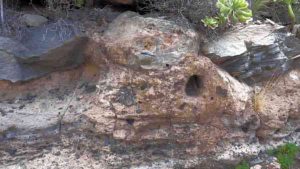
The emplacement of small-volume (<0,1km3) pyroclastic flows is strongly controlled by topography, according to a new study made by researchers of the Institute of Earth Sciences Jaume Almera of the Spanish National Research Council (ICTJA-CSIC) and University of Barcelona. The paper has been published in the journal Sedimentology.
The work has focused on the study and characterization of the Arico ignimbrite, located in the southern slopes of the Las Cañadas volcanic complex (Tenerife, Canary Islands). These rock formations were originated by the deposition of a 670.000 years old pyroclastic flow.
Guajara was the emission zone of this cloud made up of a mix of hot gases, volcanic ashes and rock fragments. This cloud showed fast downslope movement, and finally was deposited in the valleys of the southern zone of the island forming the studied ignimbrites.
“It is well known that pyroclastics flows are density currents controlled by the gravity and thus they tend to flow through valleys or depressed topographical zones”, explains Joan Martí, researcher at ICTJA-CSIC and first author of the study. “Now we have been able to demonstrate that the emplacement of small-volume pyroclastic flows is controlled by, besides the slope, the shape of the channel through which they flow. The bedrock morphology, obstacles, sudden slope variations or changes in the channel width are some of the topographical drivers that influence the emplacement and deposition of these types of pyroclastic flows”.
To do this, the team conducted fieldwork in the Barranco de los Ovejeros where they found and described a total of 57 outcrops. In this valley, the ignimbrite deposits are well exposed. Researchers studied the lithology, stratigraphy and the sedimentological features of the ignimbrite outcrops. They also measured the slope of the previous ground, depth and width of the channels that guided the transport and the final emplacement of the flow. Researchers also took 41 samples to conduct a paleomagnetic study to estimate the emplacement temperature of the Arico ignimbrite.
According to Joan Martí, despite its age, the Arico ignimbrites is a “well preserved and exposed deposit that permitted to reconstruct the paleo-topography with precision. Therefore, we were able to observe how the lithological, stratigraphical and sedimentary features of the ignimbrite deposits vary on the basis of the changes of the valley’s shape where they were finally emplaced.”
With all the field data, researchers were able to develop a theoretical model that explains the critical mechanisms from which topography guided the emplacement of the flow.
“Besides the usual parameters that define the flow regime of this type of volcanic material current, our model includes the contour conditions imposed by a particular topography which allows establishing how the flow conditions vary along with its emplacement”, notes Joan Martí.
According to the authors, this new model is “of general applicability and will help to explain other deposits of similar characteristics”.
Researchers describe in their study the different features of Arico ignimbrites along 7 observation points.
The paper notes that in the areas closest to the emission centre, the pyroclastic flow was efficiently channelled by the existing valleys that acted as efficient conduits. In these areas, the ignimbrite corresponds to a homogeneous moderately welded deposit.
The study states also that in the intermediate zones significant changes occurred in the steepness of the slope and here, although still channelled, the flow was influenced by hydraulic jumps, which controlled the way it was emplaced. In this area, two different sedimentary units can be clearly seen in the ignimbrite: the lower unit is orange, and the upper unit is grey.
Finally, in the distal areas near the present-day coastline, where the slope is very gentle or null and without a channelling relief that provoked a radial dispersion and fast degassing of the flow, only the upper unit can be found.
The researchers said that this work allows to a better understanding of the emplacement mechanisms of ignimbrites and to improve the volcanic hazard assessment. “This study opens the door to forecast the flow regime of the small-volume pyroclastic flows as long as we know the previous topography”.
Dario Pedrazzi and Domenico Doronzo, both researchers at ICTJA-CSIC, and Ferran Colombo, from the Faculty of Earth Sciences of the University of Barcelona, are the other authors of this new study.
Reference:
Martí, J. , Doronzo, D. M., Pedrazzi, D. and Colombo, F. (2019), Topographical controls on small‐volume pyroclastic flows. Sedimentology. DOI:10.1111/sed.12600
Note: The above post is reprinted from materials provided by Instituto de Ciencias de la Tierra Jaume Almera – ICTJA-CSIC. The original article was written by Joan Martí (ICTJA-CSIC).










